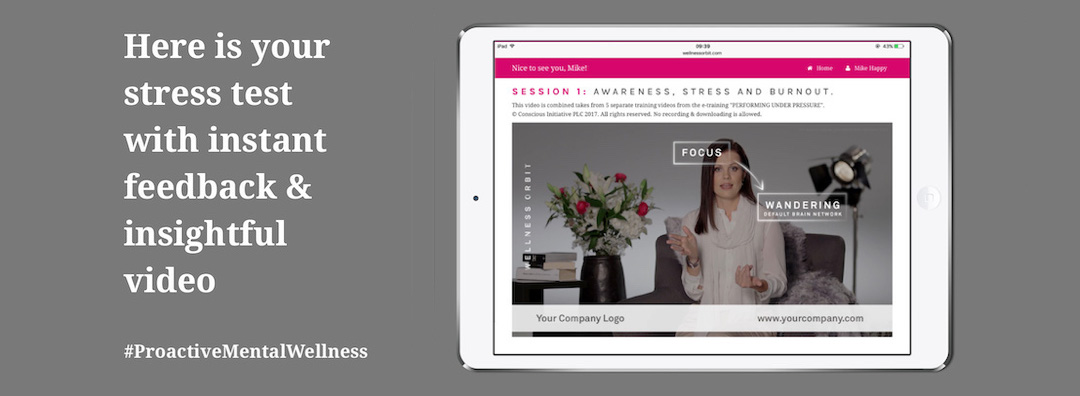Life is full of stressors. Workplace stress is a common problem that affects employees in various industries and roles. According to recent studies, 9 out of 10 employees experience high pressure or stress at work.
The next graph from the 2019 'Cigna 360 Well-being survey' carried out in 23 countries points out high-stress levels at work. 87% of employees say they are stressed and 12% felt their stress was unmanageable by themselves with their current self-leadership skills.

Being exposed to stress for long periods can cause pathophysiologic changes in the brain, and these changes again can be manifested as behavioral, cognitive and mood disorders. It can be stated that stress is either a triggering or aggravating factor for many diseases or pathological conditions.
For example, longer exposure to workplace stress can lead to physical health problems, such as cardiovascular disease (risk for hypertension, heart attack, or stroke, etc.), musculoskeletal disorders, and gastrointestinal problems. Many disorders originate from stress, especially if the stress is severe and prolonged.
The effects of workplace stress can be far-reaching. Stress has negative effects on learning, innovation and purposeful working.
According to the 2024 UK Burnout Report, over a third of adults, 35% experienced high or extreme levels of pressure and stress always or often in the past year while 95% experienced high pressure or stress during the last year.

The Burnout Report also reveals that having a supportive line manager 43% or supportive colleagues and peers 42% are among the most effective ways to alleviate workplace stress and prevent burnout. However, the most impactful strategy remains underutilized: offering employees proactive mental wellness training to address and manage workplace stress and prevent burnout.
Chronic stress is a primary driver of employee burnout, significantly impacting mental health, job satisfaction, engagement levels, and overall productivity.
In 2025, the new Burnout Report pointed out that a year later 91% experienced high pressure or stress during the last year. This can be considered as no change in the big picture. Stress reduction thus needs to be a common aim of every employer and employee! Why?
Prolonged exposure to stressors and failure to deal with inner reactivity can lead to a range of negative consequences, including decreased cognitive function, increased absenteeism, and higher turnover rates. Thus, employers and employees both win from stress reduction.
It is substantial to notice the stress symptoms early on and acquire awareness-based intrapersonal skills to lead your own inner processes at will.
Symptoms of Workplace Stress
The symptoms of workplace stress can manifest in a variety of ways, both physically and mentally.
The most common workplace stress symptoms include:
- Fatigue, exhaustion and sadness;
- Lack of self-confidence and procrastination;
- Irritability, anger, hopelessness, etc and such mood swings lead often to nervousness and anxiousness;
- Shortness of breath, difficulty of breathing or rapid breathing;
- Headaches, migraines and muscle tension (neck, shoulder, and back pain being the most common symptoms);
- Changes in appetite (loss of appetite, overeating, etc.);
- Insomnia and sleep disturbances and difficulty of relaxing and switching off;
- Reduced concentration and productivity.
These symptoms can naturally vary from person to person and may be influenced by a range of factors, including workload, job insecurity, toxic relationships with managers and colleagues and a lack of control over work tasks or work hours.
Constant "on-mode" and avoiding breaks and time off make here things worse. The main problem is that besides those symptoms there are many more subtle changes that people fail to notice due to lack of intrapersonal education.
Come and test what is your current stress situation by clicking below.
Effects of Workplace Stress
The effects of workplace stress can be significant and usually impact both employees and their employers.
When people are unwell and lack mental wellness, workplaces see increased absenteeism and presenteeism.
When people are stressed, employee engagement levels drop.
Gallup has pointed out that globally the average employee engagement level is just around 20% (see the graph below).

Additionally, employees who are stressed may have reduced job satisfaction and decreased productivity and creativity, all of which can harm the organization's bottom line.
According to Gallup applying best practices in the workplace can improve employee engagement and take it well above 70% and stress reduction is here the key to such betterment!
The most efficient stress reduction method
Stress reduction needs to start from within your mind. The key here is to learn to reduce your inner reactivity so that you can deal with all external stressors and challenges successfully.
Stressors around us are always out of our full control.
You can reduce stressors to some extent, but not avoid them. Relatively few people understand stressors and stress correctly.
The ability to remain inwardly calm and respond in an aware way allows you to notice external stressors, pause before acting to observe the situation and collect the basic data before you can determine what to do.
Keeping a calm mind and making informed conscious decisions is what prevents a cascade of problems that are present when you react subconsciously.
Chronic stress represents the main reason behind employee burnout and can impact employees' mental and physical health, job satisfaction and productivity. Thus, employers and employees both win from stress reduction.



